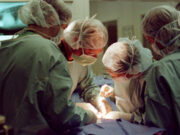The University of Georgia College of Veterinary Medicine is one of fourteen schools and colleges at the University of Georgia and one of only twenty-eight colleges of veterinary medicine in the United States. The faculty has national and international expertise in nearly every medical field, especially poultry diseases, infectious diseases, colic and lameness in horses, and pet bird diseases, among others. In 2014 the college had an enrollment of 426 students earning a doctorate in veterinary medicine and 67 Ph.D. candidates.
The College of Veterinary Medicine started small. Formed in 1946, the school was housed in Hardman Hall, formerly a livestock-judging pavilion and U.S. Navy warehouse, which was remodeled for laboratory use. War-surplus refabricated buildings served as the large and small animal hospitals. Classes opened in September of that year, with two professors and fifty-six students using borrowed tables and microscopes. They dispensed veterinary care in these makeshift facilities, until the new building was ready for occupancy in 1953. The first class graduated in 1950.
The college also offers internships and residencies, in addition to graduate programs leading to the master of science and doctor of philosophy degrees. Notable among them is the unique master of avian medicine degree program, which provides veterinarians specialized training in the diagnosis, treatment, and prevention of poultry diseases.
The college’s teaching program is based on the premise that veterinary medicine is a unique combination of medical, agricultural, and biological sciences. It is a health profession that applies principles of biomedical sciences to health and disease in animals. In the first three years of the four-year curriculum, students learn the basic medical sciences and their clinical application. The fourth year is devoted entirely to applying that knowledge in real-life clinical situations.
Much of the students’ clinical training takes place in the college’s veterinary hospital. After fifty years of growth and expansion, the number of cases seen in the hospital has grown to an estimated 20,000 animals a year—horses, dogs, cats, birds, cattle, sheep, and pigs, among others. Most of the animals admitted to the hospital have unusual, complex, or critical conditions. They are referred by the client’s veterinarian for treatment that can be found only in specially staffed and equipped facilities like the college’s veterinary hospital.
But the foremost objective of the hospital is to give students hands-on experience in the diagnosis and treatment of animals. Students are supervised by faculty members who are board-certified in various specialties of veterinary medicine and surgery, including internal medicine, surgery, radiology, dermatology, ophthalmology, cardiology, neurology, anesthesiology, reproduction, food animal and equine medicine and surgery, and herd health management.
The faculty’s involvement in veterinary medical research advances the profession while contributing to the education of graduate students. Studies are conducted on diseases of farm animals, pets, wildlife, poultry, fish, marine life, and laboratory animals. Veterinary research has important implications for human health as well, by increasing food production and protecting the food supply from diseases transmitted from animals to man.
Diagnostic laboratories in Tifton and Athens, staffed by the college’s diagnosticians and technicians, are an important service to practicing veterinarians, animal owners, and citizens of the state and nation. Partially funded by the Georgia Department of Agriculture, these laboratories test more than 100,000 samples a year submitted by veterinarians for a wide variety of disease-causing agents, such as viruses, bacteria, parasites, and toxins, to help practicing veterinarians and clinicians at the college diagnose and prevent diseases, determine cause of death, and advance teaching and research. They also provide important animal disease surveillance by reporting information to state regulatory agencies about the emergence of common diseases, as well as foreign diseases, including mad cow disease and foot and mouth disease. In addition, they identify and report the appearance of human diseases that may threaten public health.
In 2006 the college’s Animal Health Research Center, a 75,000-square-foot facility, opened in Athens. Researchers at the center focus on developing vaccines and treatments for infectious diseases found in hogs, horses, poultry, pets, and wild animals, among others. That same year the Georgia Aquarium in Atlanta collaborated with the school to offer both faculty members and students the opportunity to work and study at the aquarium’s Center for Aquatic Animal Medicine.
Since its beginnings more than fifty years ago, the College of Veterinary Medicine has risen to national and international prominence. Its graduates are in great demand, and many have become leaders in their profession.




